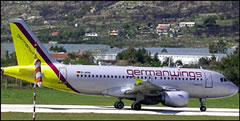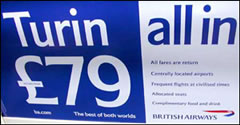No-frills airlines
What if you could fly from one end of Europe to the other for as little as $25? Welcome to the wonderful age of low-cost airlines. Here's how to use them.

No-frills airlines started off largely just shuttling Londoners to Ibiza and other holiday hotspots in the Mediterranean. Nowadays, no-frills have sprung up in Germany, Scandinavia, Italy, and elsewhere and their destinations are getting ever-more exotic and exciting. This germanwings plane, for example, just landed in Split, Croatia from Berlin and will soon take off for Cologne-Bonn.
The days of high plane fares within Europe are over, my friends, as are the days of having to spend two days on a train just to cross the continent cheaply.
Thanks to no-frills airlines and low cost carriers, you can often now hop a plane for considerably less than it costs than the train—and for far less than the former regular fare on most established airlines—while at the same time save dozens of hours on travel.
Cheaper, easier, faster—what more could you want? Well, how about making Europe more manageable? No-frills are also opening up the "corners" of Europe to travelers—Spain and Portugal, Scandinavia, Greece—turning what were once epic journeys of two or three days on trains and ferries into easy two- or three-hour flights.
In practical terms: Let's take a hypothetical trip from London to Venice:
- By train: 15 hours, $262.
- By traditional airline: 3 hours, $74.
- By no-frills airline: 3 hours, $43.
How can they do it? Well, "no-frills" means they cut a few corners—but not ones you'd really miss.
A few pointers, tips, pros, and cons
- These new airlines—currently, easyJet and Ryanair are the largest no-frills, with the widest route networks and most bases, and Ryanair is usually the cheapest among all of them by a long shot—forgo such frills as meals, movies, and free booze (though the latter is nearly extinct on traditional airlines anyway).
However, since almost all inter-European travel is short haul, who cares about getting a snack instead of a meal, or paying for your drinks, or missing in-flight entertainment?
You're on the plane for 90 minutes to three hours, max—barely time to get to cruising altitude, munch on whatever cheap snack you brought onboard, and read a chapter or two of your novel. - Seating on a no-friller is generally a first-come, first-served free-for-all familiar to anyone who has flown Southwest. You're guaranteed a seat, of course; that's not an issue. But if you're particular about getting aisle/window, or want to be sure you and your companions get to sit together, show up early enough.
- Most no-frills also shave costs on the end of operations that you don't really see (flying just one model of jet, so that maintenance and parts costs are easily contained, that sort of thing).
- They also tend to fly at less popular hours, since those "slots" at the airports are cheaper (or, more frequently, those are the only slots the airports—long in the pockets of the major airlines—will grant them).
- One of the big savings on no-frills balance books comes from the fact that they fly largely out of secondary airports at or near major cities (in London, out of Luton or Stansted rather than Heathrow or Gatwick).
Is this a problem? Not to my mind. In fact, in some cases it can be a major benefit.
Many low-cost flights use secondary airports which—in some cases—may be a bit farther out from the city than the major airport.
Why is this not really an issue? Almost all major airports are well outside town to begin with, and even with the ones that have special high-speed rail links into town, you're looking at anywhere from 20 to 60 minutes to get out there. So what's an extra 10 to 20 minutes to go all the way out to some secondary airport the no-friller uses when you're saving literally hundreds of dollars on the fare?
Smaller airports can also be a godsend to folks with a quirky itinerary in mind, allowing you to make an otherwise inconvenient flight from, say, County Kerry in Ireland to London, or London to Ancona in Italy.
What's more, smaller airports are often more convenient. With its long lines, crowds, and sheer size, I have never gotten out of London's Heathrow in less than an hour and a half. However, on a no-frills flight from Barcelona to London's Luton airport, the plane taxied right up to the arrivals gate, I walked down the staircase, across 50 feet of tarmac, and through the doors.
I glided past the smiling passport clerk and waited at the luggage belt immediately beyond for but a few minutes before my bag trundled its way out on the belt. I checked my watch as I exited the airport and crossed the sidewalk to the bus that would take me to downtown London.
Time from stepping off the plane to boarding the bus: 12 minutes.
Beat THAT Heathrow!
Perhaps the best thing about no-frills airlines is that all tickets are priced one-way, all the time.
That means you can easily hopscotch your way across the Continent without ever having to return to some central or origin airport first.
You could fly transatlantic into London, and then use cheap no-frills tickets on any of a variety of airlines (no need to be loyal to just one) to fly first down to Venice, from there amble over to Athens, then mosey on up to Munich, bop over to Barcelona, and finally lug all your souvenirs back to London for your flight home.
Connecting the dots thusly (by flying first into London—always the cheapest European gateway) is called the Big Ben Switcheroo, and the strategies, secrets, and pitfalls involved are described in detail elsewhere on this site. For now, let's look at a few drawbacks to the no-frills phenomenon.
Most no-frills have strict (on some, draconian) baggage weight limits and charge exorbitantly steep fees if you go over—not only for your checked bag, but for your carry-on as well. (Ryanair is the worst; they're actually mean about it.)
Travel writers accumulate an obscene amount of research in the form of brochures and other heavy paper items, and I've ended up paying more at the check-in counter for my excess baggage than for my plane ticket! ![]()

Traditional airlines have been forced into a price war with the low cost carriers. This British Airways ad from a London tube train shows how far the flagship carrier has had to lower prices in order to compete with the low-cost upstarts. The ad also takes a swipe at the "no-frills" part of no-frills airlines by reminding us of the benefits to flying a major carrier—"centrally located airports, frequent flights at civilized times, allocated seats, complimentary food and drink." It also makes a big deal out of all fares being "return" (British for "round-trip"), which is odd since the one-way pricing on an LCC offers far more flexibility.
Now that the no-frills are clearly here to stay in Europe, the traditional big airlines over there have finally come down off their high-fare horses, rolled up their sleeves, and started trying to stem the tidal wave of inter-Continental traffic away from their flag carriers.
What I mean is, the Big Boys have had to slash their fares to the bone to compete—in several cases after having failed miserably, and at great cost, in ill-guided attempts to beat the low-cost carriers at their own game by creating puppet low-cost subsidiaries.
(Most of these sad offshoots of the majors went under within a year or two, their remains gobbled up by the true upstarts—anyone remember Delta's "song" and United's "Ted?").
This is good news all around, since now you might even be able to find a decent fare on an established airline. The no-frillers still tend to trounce them in the pricing war, but the options offered by more airlines is nice.
Also, as the snarky British Airways' ad from a London Tube train pictured above trumpets, if you do want to book with an old guard carrier (and pay a bit more), you will still get some of those frills that the cheapies are lacking.
The 1990's deregulation and privatization of many national airlines in Europe opened the door to a slew of start-up competitors with names like easyJet, Ryanair, and germanwings (similar to Southwest and jetBlue here in the States).
Some are financed by major airlines or tourism-industry backers; some are true newbie entrepreneurs; some are old charter services that are revamping to fit the new "no-frills" model.
All of these young no-frills outfits are now feistily muscling their way into the business and travel sectors by offering cut rates on what were once laughably inflated ticket prices between European cities. Some compete as an alternative in their own national market; others are crisscrossing Europe from a central hub along a handful of useful and carefully selected routes.
Most are London-based, though the German, Scandinavian, and Eastern European markets are becoming the new frontier.
This is all fantastic news. The page on resources for finding and booking no-frills airlines will help you track down the current crop of low-cost carriers.
Resources for finding and booking no-frills airlines >>
Related Articles
|
|
This article was by Reid Bramblett and last updated in June 2012.
All information was accurate at the time.
Copyright © 1998–2013 by Reid Bramblett. Author: Reid Bramblett.
